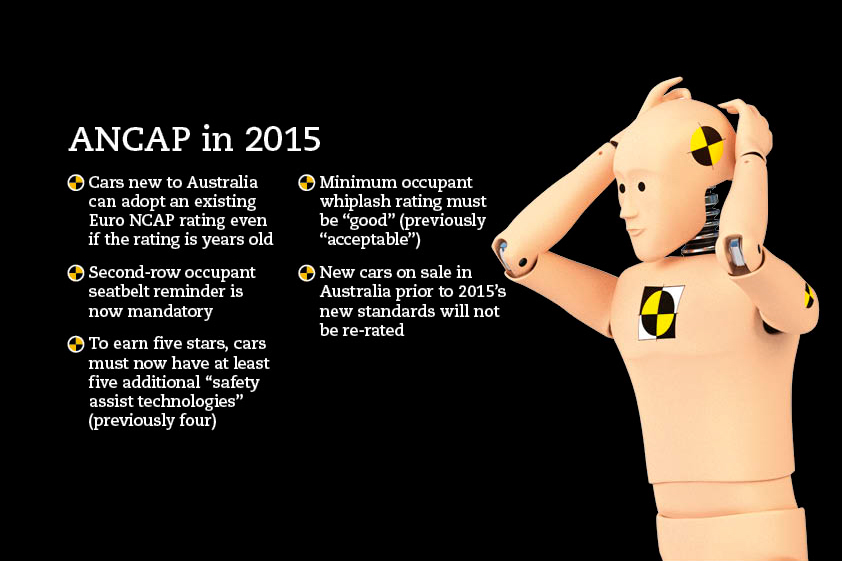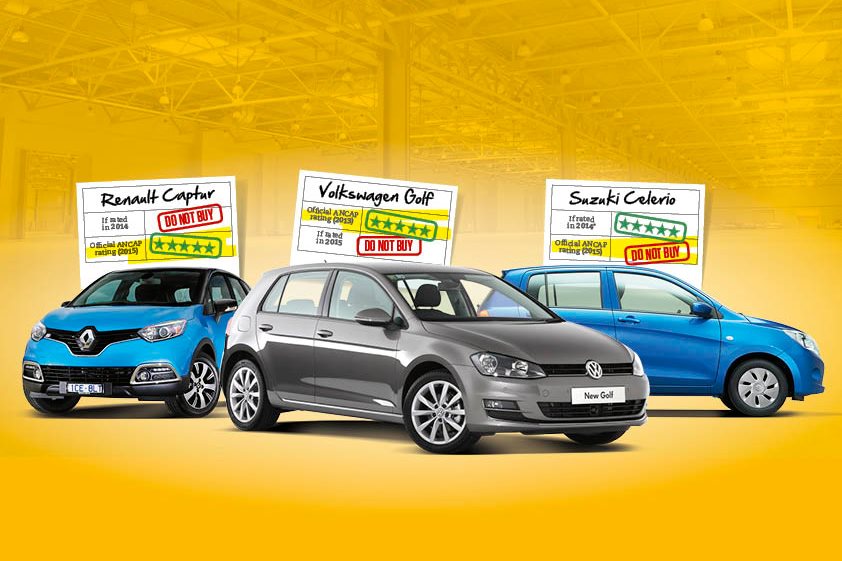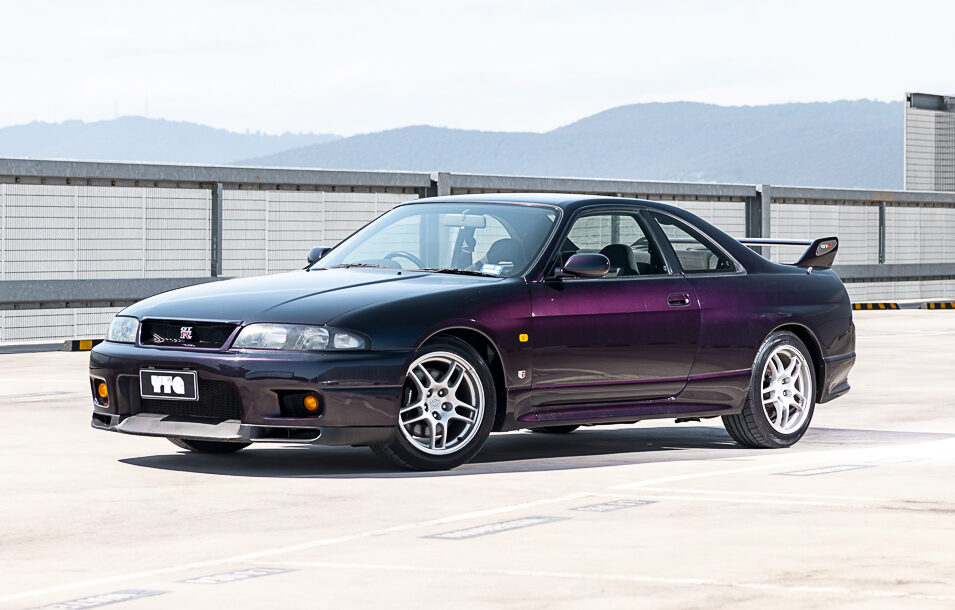MORE than half the 179 new cars on sale rated as having a perfect five-star safety score by the Australasian New Car Assessment Program (ANCAP) would not maintain that rating if evaluated to 2015 standards, which came into effect on January 1.
Conversely, some four-star cars launched in 2014 would have achieved five-star safety endorsements if their Australian market launch had been delayed until 2015, or if the manufacturers had chosen to fit one or two peripheral ‘safety assist technologies’ (SATs) with debatable real-world bearing on occupant protection.
These discrepancies in ANCAP safety ratings are confusing for consumers, and could be costing car companies sales.
Increasingly safety-aware shoppers – including influential fleet and government buyers – who do not understand what the changes mean may be wiping recently released four-star models off shortlists for the wrong reasons.
Through its own marketing campaigns, ANCAP actively encourages buyers to “cross it off your list” if a car does not have a five-star rating – even if the vehicle is among the safest in its class.
Further confusing the process of choosing a safe car is ANCAP’s shift into a new “transition period” whereby the independent safety watchdog, which receives about a third of its income from taxpayers, will be locked into incompatible protocols from its European equivalent, Euro NCAP.
This loophole has led to at least one new car – the Renault Captur – inheriting a five-star Euro NCAP rating despite lacking what ANCAP describes as “vital” side curtain airbags that can save the lives of rear-seat passengers.
“The Captur is one of the small anomalies of the transition [to Euro NCAP protocols],” ANCAP communications manager Rhianne Robson said. “Obviously … there will be certain things that aren’t watertight in the transition.”
ANCAP CEO Nicholas Clarke points to recently introduced “date-stamping” – whereby the test date of a vehicle is specified – as an aid to consumers understanding the year a vehicle was rated. But ANCAP only applies date-stamping to vehicles tested from July 2014.
“The importance of the carry-forward of the 2013 rating for Renault and for consumers is that it’s actually a two-year-old car that’s rated to two-year-old standards, and that’s the message that consumers will take,” he said.
However, the ‘five-stars-or-nothing’ message promoted by ANCAP means many consumers may not look beyond the five-star ratings or understand the distinction of a vehicle tested a year or more earlier.

Wheels’ exclusive investigation into ANCAP safety ratings shows many five-star cars lack safety features the organisation considers crucial, such as rear curtain airbags, which ANCAP chairman Lauchlan McIntosh refers to as a “vital safety feature”.
Wheels identified at least 90 new cars rated five stars by ANCAP that would not maintain that rating if recalculated to today’s ANCAP protocols. They include popular models such as the Toyota Corolla, VW Golf, Holden Trax, Toyota LandCruiser and Ford Territory, plus a variety of dual-cab utes, including the Toyota Hilux, Mazda BT-50 and Ford Ranger. Most are missing only a reminder system for the rear seatbelts.
The new criteria and associated transition period has led to some cars with near class-leading safety levels scoring only four stars because they are missing a single SAT such as hill-start assist or daytime running lights.
Wheels believes ANCAP’s new requirement for a minimum number of SATs – on top of a sound crash structure, suitable airbag coverage, good pedestrian protection and other traditional elements credited with saving lives – could be misleading consumers about which cars are safe and which are not.
Some SATs are mandatory to achieve a five-star rating. They include ESC, side curtain airbags for the first and second row of seats, and seatbelt reminders for the first and second row seats.
However, carmakers need up to five additional SATs to achieve a five-star rating, some of which appear to have little or no potential for reducing crashes. They include a smart key, which ensures the “vehicle will not operate without an appropriate electronic key”, trailer stability control, which is relevant only for vehicles used for towing, and hill-start assist, which ANCAP claims “avoids the need for the driver to go through an awkward sequence of events involving the parking brake to hold the car momentarily whilst on a hill”.
One of the biggest inequalities with the ANCAP rating system concerns the protocols applied to the year a vehicle earned its rating. A vehicle’s ‘model-life’ can stretch up to 12 years, so it’s not unusual for its safety rating to be many years old. Vehicles rated by ANCAP in previous years are not penalised despite missing now-mandatory safety features. “We don’t apply our ratings retrospectively,” Ms Robson said. “The ratings are particular in which year the model was launched generally. Yes, there may be a vehicle launched two years ago that doesn’t meet five additional SATs, because the requirements in that year were only three additional SATs.
“What consumers need to acknowledge is that they need to look for a five-star rating; whether that’s a car rated in 2008, the five-star rating for that year is the best safety performer at that time.”
ANCAP CEO Clarke referenced fridge energy use ratings and also pointed to hotel ratings as facing similar problems. “How does a consumer know if a five-star hotel that was rated in 2010 is the same as a five-star in 2015?”
Clarke said re-evaluating cars was unnecessary because “a car is rated to a standard at a particular date”. However, recalculating a car’s score would not require more crash testing, which is by far the most expensive component of the ANCAP process.
Clarke said recalculating the rating of a car is an involved process, despite admitting the physical crash tests have changed little. “There is an enormous amount of science and engineering that goes into this program. This is not a box-ticking exercise. There is complex processes in place.”
He said new ratings protocols adopted on January 1, 2015, which saw the Suzuki Celerio – launched on March 1 – marked down to four stars for missing one SAT, was not indicative of overall ANCAP results.
“It’s pretty easy to sort of get hung up on a couple of what we think are more sort of outliers,” Clarke said.
ANCAP has tried to highlight the issues of older cars tested to older standards with its date-stamping. But there is little explanation of the differing requirements as ANCAP standards have changed – including what occupant protection or crash-avoidance technology an older five-star car may be lacking.
This information is on the ANCAP website in a 19-page document available for download. However, it reads as though written for industry insiders rather than less knowledgeable consumers, and is incomplete, listing six references to features where the assessment method is “TBA” (to be announced) and four where the definition of a feature is “TBD” (to be determined).
It’s not easy for buyers to understand why a car is considered less safe by ANCAP. The difference could be as simple as the lack of an automated handbrake or the wrong car key. Or it could be as serious as poor structural crash protection or the omission of life-saving airbags.
ANCAP’s rating inconsistencies give new vehicles released prior to 2014 an unequal advantage in car dealerships, and could give buyers false assurance that a vehicle rated five stars by ANCAP is safer than a four-star one.
The ANCAP message, by its own admission, is simple: four stars is not safe enough, five stars is. But, as Wheels has discovered, not all five-star cars justify their top safety rating against current ANCAP standards.
In some cases, a four-star rival may actually be the safer choice.
ANCAP ‘falling behind’ on safety Founder says Australian body is no longer a world leader
TWO people instrumental in setting up ANCAP in the 1990s have criticised Australia’s crash test authority as becoming less relevant to car buyers and less nimble in its ability to adapt to new technologies and trends.
Road safety consultant Michael Griffiths told Wheels the taxpayer-funded organisation had lost its innovative approach and was now behind other crash testing authorities.
“It’s a shame that a program that was world leading is now world lagging,” Griffiths said, pointing to the US Insurance Institute for Highway Safety as a leader in occupant protection. “ANCAP should be taking the same innovative route as IIHS rather than being tied to a program that has the limitation of a committee needing to represent all of Europe’s interests.”
Griffiths highlighted new test procedures used by IIHS – including the punishing small-overlap test introduced in 2012 and the side-impact sled test developed in 2003 – as better simulations of side impact from a higher-riding SUV. “This is the kind of initiative ANCAP should be taking.”
According to ANCAP’s annual report for 2013/2014, of $3.5 million in income (comprising $1.1 million in government grants, $2 million in subscriptions revenue and other income) less than half – just $1.6 million – was spent on the “cost of test program”.
The report shows more than $400,000 was spent on “communications and marketing”, including $96,170 on travel, as well as advertising, events and website costs. The books closed with a $250,000 surplus.
ANCAP CEO Nicholas Clarke defended the organisation’s spending.
“That’s nonsense; we’re spending more on tests than we ever have. The funds that we get in through our members is only a fraction of what we spend on crash tests. “You’re forgetting we’re a not-for-profit [organisation]. We make money through all sorts of channels in kind and in cash. We get … probably $4.5 million on average in ratings from Euro NCAP for free. We get manufacturers assisting with the donation of tests and cars. These are not things that hit the balance sheet.”
Dr Tom Gibson – a visiting professor at the University of Technology, Sydney, and a director of Human Impact Engineering, a consultancy company that deals with the biomechanics of impact injury – also believes ANCAP is losing relevance.
Gibson, who was involved with Griffiths in establishing ANCAP, agrees the testing procedure needs to focus more on occupant protection and developing more difficult and relevant tests.
“The critical issue at present is the compatibility of vehicles,” said Gibson. “When a light vehicle hits a heavy vehicle … the little vehicle isn’t going to do well, no matter what ANCAP says.”
ANCAP touches on the incompatibility of large and small vehicles in its website’s FAQ section: “It is not appropriate to compare ANCAP safety ratings across vehicle categories, particularly if there is a large weight difference.”
However, Wheels believes the simplified ‘five-star only’ message overlooks these potential dangers. And ANCAP has done little to evaluate vehicle mass differences, increasingly important in a country where one in three new cars is an SUV.
Gibson also questions whether Australia has the money or resources to justify its own NCAP testing. It’s a topic of contention as local manufacturing approaches its 2017 end-date.
“There was more reason [to have a local NCAP] when we had more unique models,” Gibson said. “It seems to me Australia could get better bang for their bucks if they did things differently.”
Star-struck cars risk sales snub Safer maybe, but no longer on shopping lists
SAFER cars could be more expensive to register and insure due to inconsistent and confusing crash ratings.
ANCAP has successfully lobbied fleets, large companies and governments to only purchase cars with five-star ratings. The national marketing communications manager of LeasePlan Australia, Paul Scully, said the star ratings are “increasingly important to fleet buyers, governments in particular … the car is seen as part of the workplace and ANCAP is the rating they rely on”.
However, such fleet purchasers could be missing out on the latest safety features because of ANCAP changing its requirements and entering a “transition period” culminating in the 2018 adoption of Euro NCAP protocols.
The Suzuki Celerio, for example, is one of the few cars in its class to feature seatbelt reminders in the rear seats, something now mandatory for a new five-star rating. It also protects occupants well in a crash, according to Euro NCAP’s data (supplied to ANCAP), and has the second-highest pedestrian protection score for a light car.
However, because it arrived in Australia in 2015, the Celerio requires five additional safety assist technologies to achieve a five-star rating. It fell short by one SAT, so was rated as four stars, with ANCAP recommending buyers shop for another car.
However, Wheels’ own investigation reveals that of 12 major light car competitors, the Suzuki is one of the safest. If Suzuki fitted a hill-hold system, for example, it would almost certainly be upgraded to five stars.
Four-star cars could soon also be more expensive to register. Last year, NSW roads minister Duncan Gay released a discussion paper proposing higher registration fees for cars without a five-star ANCAP rating. A department spokesperson told us “a final report will be prepared for the government’s consideration and approval in due course”.
The ANCAP safety message can also go the other way. The simplified “accept nothing less” message from ANCAP says “consumers should look for vehicles that have earned the maximum five-star ANCAP safety rating”, but many older cars that still boast that rating miss out on now-mandatory “safety assist technology” or potentially life-saving airbags. The ANCAP website states cars rated four and five stars have “head-protecting technology (side curtain airbags)”. But many ANCAP five-star cars – including the Volkswagen Amarok and Beetle, and Renault’s Clio and Captur – do not have full-length curtain airbags.
The Tata Xenon, which gets four stars, has no side airbags at all and an inferior lap-only seatbelt in one seat.
ANCAP also claims “a vehicle must achieve the highest standards in all tests and feature advanced safety assist technologies (SAT)” to earn five stars, yet many such cars do not meet the current ANCAP requirements for safety assist technologies.





